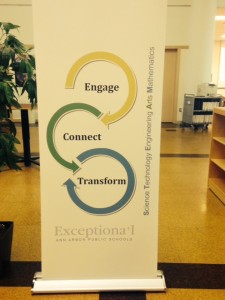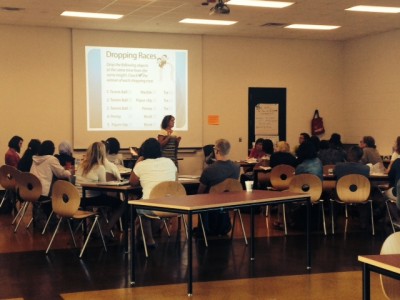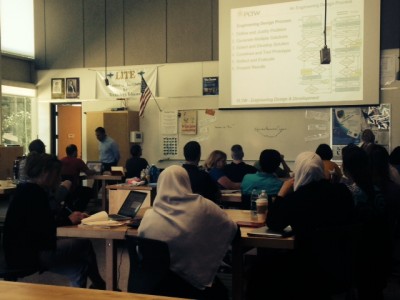Dr. Jeanice K. Swift, Superintendent

You likely have heard that Ann Arbor Public Schools is the fortunate beneficiary of an exciting partnership with Toyota Motor Sales that supports and enhances our implementation of STEAM education in AAPS.
I shared in a recent blog post about the education exchange we experienced this summer with 20 of our teachers and leaders who participated in studying and sharing about STEAM learning with our education partners in Singapore.
We are currently engaged, as a district, in very exciting work to extend the Singapore STEAM learning and expand learning opportunities for AAPS teachers in STEAM practices and to implement STEAM across all our AAPS schools.
STEAM Professional Learning Academy in AAPS
During the week of August 11-14, we extended the learning from our Toyota partnership as our teachers and leaders participated in a Professional Learning Academy hosted at Skyline High School, and sponsored by our partners at Toyota, to explore STEAM education in AAPS. Presenters for these exciting sessions included our Singapore Delegation members from summer, 2013 and 2014 as well as daily sessions highlighting STEAM careers and offered by our partners at Toyota Motor Sales. Overwhelmingly, feedback from teachers who participated in these sessions was positive, and the PLA sessions was a wonderful time to observe teacher enthusiasm around innovating STEAM classroom practice.

Defining a vision of STEAM Learning in AAPS
Often, teachers, parents, and students pose important questions about STEAM such as:
- “What is STEAM learning, really, and how does it differ from traditional education?”
- “Why did we add the ‘A’ – I thought it was called STEM?”
- “What did you do with literacy and social studies; we still teach those subjects, yes?”
- “Is this just another fad in education?” and
- “Why is STEAM learning so important?”
- “Is STEAM learning featured in all AAPS schools, or just in those with specialized programs?”
These are excellent questions.
As we have participated in two summers of study abroad with AAPS teachers and leaders and continued our work in learning communities right here at home in Ann Arbor Public Schools, are pleased to progress in clarifying what, more precisely, we mean when we use the phrase, ‘STEAM learning’ and to articulate a coherent vision of STEAM education across the Ann Arbor Public Schools.
STEAM is about an approach to engage students in their learning – where the lines between subject areas are intentionally blurred, where learning becomes focused more for real-life, authentic purposes, and where critical thinking, collaboration, communication and working to solve problems are the cornerstones of the learning experience. STEAM opens up the classroom to connect students to explore creative solutions to problems we face; in authentic project-based learning, students are encouraged to try, to experiment, to fail, and to learn from experience.

STEAM in AAPS: Engage. Connect. Transform.
In Ann Arbor Public Schools, we consider our approach to implementing STEAM learning in three parallel pathways, along three lines of endeavor, and I often compare these pathways to a ‘sprinkle, rain, pour’ analogy.
First, we engage students in STEAM learning, developing STEAM ‘habits of mind’ in all of our Ann Arbor classrooms. This pathway includes practicing and developing the skills of exploring real-world problems, learning across content areas, developing the habits of critical and design thinking, and producing authentic work for a real-world audience. For example, in STEAM classrooms, students don’t just study scientists, they become scientists. In beginning to implement these subtle shifts in how we design the learning environment, every classroom becomes a STEAM learning opportunity and our students experience STEAM learning every day in AAPS classrooms.
Examples of the sprinkle approach to STEAM learning can be as simple as: using a design process to create a project, pursuing a learning endeavor – across multiple content areas – to solve a real-world problem, or presenting a performance of learning beyond the four walls of the classroom.
Secondly, we have been on a mission for several years to develop focused program options where students have the opportunity to connect with full STEAM learning experiences as a part of their AAPS education experience. These learning experiences occur as part of the day, a portion of the week, or at a dedicated time during the year. Students connect with particular STEAM learning experiences, for example, within a Project Lead the Way (PTLW) classroom, in an after-school robotics club, or in one of our many Rec & Ed STEAM learning opportunities.
We are excited to share that with the addition of PTLW at Northside K-8, AAPS will soon be one of few districts in the country to offer the PLTW program across grades K-12. This past summer, Rec & Ed offered several STEAM-themed camps, including one where student campers engineered underwater ‘rovers’ that they used to explore the Huron River. Rec & Ed is offering more project-based, hands-on learning opportunities with after school classes such as WeDo Robotics, Lego Mindstorms and Video Game programming; Rec & Ed offers STEAM classes and camps for children as young as three. In implementing these carefully designed, full-on STEAM learning experiences, AAPS students may choose to ‘dive in’ to STEAM learning in a variety of ways in specific dedicated classrooms, after-school clubs and activities, and through quality Rec & Ed experiences.
Finally, as we consider the progression of implementing STEAM learning along three pathways, we also recognize opportunities to transform specific learning environments via immersive STEAM learning opportunities. These innovative learning experiences have been designed, from their inception, to foster STEAM learning, and they engage students in making a global impact through their learning. These full-on STEAM learning settings often impact life identity for students, as they are transformed by the work they create.
To tap into these kind of transformational learning experiences, students may enroll, for example, in the Engineering and Design magnet at Skyline High School, pursue a K-8 education at STEAM at Northside, or dual-enroll in university coursework while still in high school. Whole- environment experiences such as these are designed to support students with a fully immersive STEAM learning experience from which they may pursue a STEAM–related higher education opportunity or career. Students in these types of learning experiences assume a ‘life-identity’ and have the opportunity to ‘try on’ high-level STEAM work.
I have had the wonderful opportunity to observe students from the Communication, Media, and Public Policy Magnet as they pursue solutions to real-life problems; an example of a few of their public service videos can be viewed here: http://www.skylinecmpp.com/default.html You will notice that the opening page of the website reads: Real Problems. Real Projects. Real Clients. – this is a great summary of transformational STEAM learning. If you have not yet seen their video, Tuition Equality, it is a compelling must-see and a perfect example of real-life learning applied to real-world challenges (it may be accessed at the Skyline link above).
In addition, students in the Engineering & Design magnet consistently work in areas of groundbreaking research and design. Transformation is key to these fully immersive STEAM learning experiences where student is central to the learning and teacher serves as facilitator, where students no longer serve as consumers of learning but rather become the creators.
In developing our AAPS STEAM implementation, we know that all of our students will be better prepared for the world they will face as we continue work along these three pathways: Engage. Connect. Transform. In AAPS, all our students will regularly experience STEAM learning as an added dimension of a quality learning environment. They will develop the skills and ‘habits of mind’ to explore and connect across content areas, dive in to focused STEAM learning as a part of their day, week, year, and can choose opportunities to immerse themselves in one of our special programs designed to facilitate a STEAM transformation.
As they say at Ann Arbor Rec & Ed, in AAPS, we are Full Steam Ahead this year as our teachers and leaders continue to accomplish tremendous work to innovate learning through STEAM enriched classrooms in the Ann Arbor Public Schools. Please continue to engage and connect with us as we enhance the work to transform all learners into leaders.

Be the first to comment